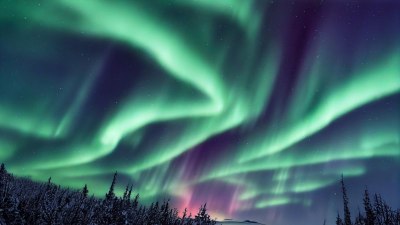How to Sleep Under the Northern Lights Without Freezing - Yes, It’s Possible
Discover how to enjoy a night under the Northern Lights without the chill. Tips for staying warm in Arctic conditions.

Experiencing the Northern Lights is a dream for many. The stunning colors dancing across the Arctic sky is a spectacle that leaves onlookers in awe. However, the challenge of viewing this natural wonder often lies in the extreme cold that accompanies it. Fortunately, with the right preparation and tips, you can comfortably spend a night under the lights without freezing. Here’s how you can enjoy this incredible experience while staying cozy and warm.
Understanding the Northern Lights
The Northern Lights, or Aurora Borealis, are natural light displays predominantly seen in high-latitude regions around the Arctic and Antarctic. They occur when charged particles from the sun collide with Earth's atmosphere, creating beautiful waves of color in the sky. Traditionally, these lights are best viewed during the winter months when the nights are long and dark, and the skies are clear.
Choosing the Right Location
The first step to ensure a comfortable night under the Northern Lights is choosing the right location. Look for areas known for their visibility of the auroras, such as northern Canada, Alaska, Greenland, or Norway. Opt for places with low light pollution, where the clarity of the sky is not obstructed by city lights. Researching local weather conditions can also help, as clear skies are crucial for a successful viewing experience.
Timing Your Adventure
Timing is everything when it comes to viewing the Northern Lights. The best chances of seeing them are during the winter months, from September to March. However, the peak months are usually from December to February, when the temperatures are lowest, but also when the nights are longest. Plan your trip accordingly to maximize your chances of witnessing this breathtaking phenomenon.
Dress for Success
Staying warm is the key to enjoying your night under the Northern Lights. Dress in layers, starting with a moisture-wicking base layer made of materials like merino wool or synthetic fabrics. Avoid cotton as it retains moisture and can lead to a chill. Layer up with insulating materials like fleece or down, and finish with a waterproof and windproof outer layer. Don’t forget warm socks, insulated gloves, and a hat that covers your ears, as heat escapes from these areas quickly.
Invest in Sleeping Gear
Your sleeping gear is crucial for maintaining warmth. A high-quality sleeping bag rated for extreme temperatures is essential. Look for bags designed for winter camping, which have built-in insulation and draft collars to trap heat. Additionally, use a sleeping pad to provide insulation from the cold ground, and consider bringing an extra blanket for additional warmth. An insulated liner can also help add extra warmth to your sleeping bag.
Utilize a Hot Water Bottle
Before heading to bed, fill a water bottle with hot water and place it in your sleeping bag. This can create a warm spot that will help keep you warm throughout the night. Just be sure to use a bottle that won’t leak, and allow the bottle to cool a bit before you tuck it in with you to avoid burns.
Know Your Fire Safety
If you're camping in an area that allows fires, setting up a campfire near your sleeping area can provide warmth and a cozy atmosphere. However, it's essential to follow proper fire safety protocols. Build your fire at a safe distance from your tent or sleeping area, keep it small, and always ensure it's completely extinguished before going to sleep. Even if you can’t have a fire, having a reliable source of heat (like a portable propane heater) can make a significant difference in keeping warm.
Bring Portable Heating Solutions
If camping in extreme cold, consider bringing a portable heater designed for camping use. These compact heaters can provide a significant amount of warmth, especially when used inside a well-ventilated tent. Always follow the manufacturer's instructions and safety guidelines when using gas heaters to avoid carbon monoxide poisoning.
Staying Hydrated and Fed
Maintaining your energy levels is essential for overall warmth and comfort. Even in cold weather, it’s easy to forget to eat and drink. Bring high-energy snacks and warm drinks to keep your body fueled. A thermos of hot soup or tea can help keep you warm from the inside out. Eating regularly will generate body heat, helping you stay warmer throughout the night.
Use an Insulating Ground Cover
Using a ground cover can significantly impact your warmth while sleeping on cold surfaces. A tarp or an extra sleeping pad beneath your sleeping bag will provide an additional layer of insulation and protect you from moisture that might seep up from the ground. Make sure the ground cover is secured to prevent it from blowing away in windy conditions.
Make the Most of Your Tent Setup
If you're camping, your tent choice can impact your experience under the Northern Lights. Choose a four-season tent designed for winter camping, as these tents trap heat more effectively and withstand wind and snow. Properly stake down your tent to prevent it from being blown away by strong winds, and consider adding extra insulation inside with sleeping pads or blankets.
Manage Expectations
Part of enjoying the Northern Lights experience is managing your expectations. While you might have planned for a cozy night, weather conditions can change. Be prepared for the possibility that you may not see the auroras during your trip. Embrace the adventure, enjoy the surroundings, and consider the experience of sleeping in nature under the stars, regardless of the auroras.
Finding Local Guides
Consider hiring a local guide who specializes in Northern Lights viewing. Guides can provide insights on the best locations, historical context about the lights, and tips on photography if you wish to capture the moment. They often have equipment and local knowledge that can maximize your enjoyment and keep you safe in colder conditions.
Be Prepared for Fluctuating Temperatures
In polar regions, temperatures can drop significantly at night. Be ready for these fluctuations by checking the forecast before your trip and packing accordingly. Adding extra layers to your sleep setup, such as additional blankets or sleeping bags, can counteract this and help you stay warm if temperatures dip unexpectedly.
After-Viewing Activities
If you are camping or staying out for long hours, consider planning some fun activities to break up the cold evening. Stargazing, telling stories around the campfire, or even engaging in snow activities like snowshoeing can help keep spirits high and your body warmer.
Wrap Up Your Adventure
Sleeping under the Northern Lights is an unforgettable experience, and with the right preparation, it’s possible to do so without being overwhelmed by the cold. By dressing properly, investing in suitable sleeping gear, utilizing heating methods, and being aware of safety protocols, you’ll be able to enjoy this incredible natural phenomenon comfortably.
When done correctly, sleeping under the Northern Lights can be a magical experience that creates lifelong memories. With this comprehensive guide, you can confidently prepare for your adventure. Embrace the beauty of the night sky, let the colors of the auroras inspire you, and revel in the joy of experiencing one of nature’s most spectacular shows with comfort and warmth.











